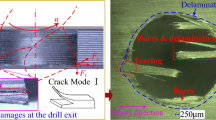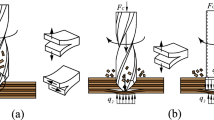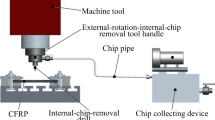Abstract
Due to the excellent performance of carbon fiber-reinforced plastic (CFRP), it is used more and more widely in the form of pipe and shaft parts. In order to reveal the formation mechanism of CFRP pipe concave drilling defects, the causes of hole entrance defects, exit defects, and exit sidewall defects were analyzed by combining theory with experiment, and the effects of different processing parameters on hole exit delamination defects were studied. Through theoretical analysis, it is found that the delamination at the front end of the chisel edge does not necessarily affect the final defects of the hole in CFRP pipe concave drilling. The experiment proves that the chisel edge can effectively drill through the outermost material and has no effect on the formation of the final hole damage. When the candle stick drill is used for drilling, there is almost no damage at the hole entry. After the outermost woven fiber cloth is drilled through, different degrees of damage occur at the intersection of longitudinal and transverse fibers.














Similar content being viewed by others
Data availability
The data and material in this paper are original, available, and objective.
Code availability
Not applicable.
References
Jia ZY, Zhang C, Wang FJ, Rao F, Chen C (2020) Multi-margin drill structure for improving hole quality and dimensional consistency in drilling Ti/CFRP stacks. J Mater Process Technol 276:11640510. https://doi.org/10.1016/j.jmatprotec.2019.116405
An Q, Dang J, Li J, Wang C, Chen M (2020) Investigation on the cutting responses of CFRP/Ti stacks: with special emphasis on the effects of drilling sequences. Compos Struct 253:112794S0263822320327203
Xu W, Zhang L (2018) Tool wear and its effect on the surface integrity in the machining of fibre-reinforced polymer composites. Compos Struct 188:257–265. https://doi.org/10.1016/j.compstruct.2018.01.018
Wang XM, Cao W, Deng CH, Wang PY, Yue ZF (2015) Experimental and numerical analysis for the post-buckling behavior of stiffened composite panels with impact damage. Compos Struct 133:840–846. https://doi.org/10.1016/j.compstruct.2015.08.019
Wei XY, Li DF, Xiong J (2019) Fabrication and mechanical behaviors of an all-composite sandwich structure with a hexagon honeycomb core based on the tailor-folding approach. Compos Sci Technol 184:107878. https://doi.org/10.1016/j.compscitech.2019.107878
Yang M, Hu YF, Zhang JG, Ding GP, Song C (2018) Study on forced torsional vibration of CFRP drive-line system with internal damping. Appl Compos Mater 25(6):1307–1322. https://doi.org/10.1007/s10443-017-9668-7
Alabtah FG, Mahdi E, Eliyan FF (2021) The use of fiber reinforced polymeric composites in pipelines: a review. Compos Struct 276:114595. https://doi.org/10.1016/j.compstruct.2021.114595
Ding Z, Weeger O, Qi HJ et al (2018) 4D rods: 3D structures via programmable 1D composite rods. Mater Des 137:256–265. https://doi.org/10.1016/j.matdes.2017.10.004
Jia Z, Chen C, Wang F, Zhang C, Wang Q (2020) Analytical model for delamination of CFRP during drilling of CFRP/metal stacks. Int J Adv Manuf Technol 106:5099–5109. https://doi.org/10.1007/s00170-020-05029-y
Zhu W, Fu H, Li F, Ji Xu, Li Y, Bai F (2022) Optimization of CFRP drilling process: a review. Int J Adv Manuf Technol 123:1403–1432. https://doi.org/10.1007/s00170-022-10112-7
Xu WX, Zhang LC (2019) Heat effect on the material removal in the machining of fibre-reinforced polymer composites. Int J Mach Tool Manu 140:1–11. https://doi.org/10.1016/j.ijmachtools.2019.01.005
Geier N, Szalay T, Biró I (2018) Trochoid milling of carbon fibre-reinforced plastics (CFRP). Procedia CIRP 77:375–378. https://doi.org/10.1016/j.procir.2018.09.039
Hocheng H, Chen CC, Tsao CC (2018) Prediction of critical thrust force for tubular composite in drilling-induced delamination by numerical and experimental analysis. Compos Struct 203:566–573. https://doi.org/10.1016/j.compstruct.2018.07.051
Zhao W, Zhang W, Duan Z, Yang F, Xu J (2021) Torsion properties of carbon fiber-metal transmission shaft based on delamination damage analysis. Acta Materiae Compositae Sinica 38(5):1466–1486. https://doi.org/10.13801/j.cnki.fhclxb.20200723.005
Li S, Zou S, Dai L, Zhou Y, Qiu X, Li C, Li P, Ko TJ (2022) Damage mechanism of carbon fiber reinforced plastic pipe based on reverse and forward curvature drilling. Compos Struct 292:115700. https://doi.org/10.1016/j.compstruct.2022.115700
Erturk AT, Vatansever F, Karabay EYS (2019) Machining behavior of multiple layer polymer composite bearing with using different drill bits. Compos Part B Eng 176:107318. https://doi.org/10.1016/j.compositesb.2019.107318
Gemi L, Morkavuk S, K¨oklü U, Gemi DS (2019) An experimental study on the effects of various drill types on drilling performance of GFRP composite pipes and damage formation. Compos Part B Eng 172:186–194. https://doi.org/10.1016/j.compositesb.2019.05.023
Norbert G, Csongor P, Dániel IP, Barnabás ZB (2021) Drilling of curved carbon fibre reinforced polymer (CFRP) composite plates. Procedia CIRP 99:404–408. https://doi.org/10.1016/j.procir.2021.03.057
Qiu X, Li P, Niu Q, Li S, Li C, Tang L (2022) Formation mechanism of drilling defects on CFRP pipe surface. Acta Materiae Compositae Sinica, (In Chinese) https://doi.org/10.13801/j.cnki.fhclxb.20220315.001.
Qiu X, Li P, Tang L, Li C, Niu Q, Li S, Tang S, Ko TJ (2022) Determination of the optimal feed rate for step drill bit drilling CFRP pipe based on exit damage analysis. J Manuf Process 83:246–256. https://doi.org/10.1016/j.jmapro.2022.09.002
Hocheng H, Tsao CC, Chen HT (2016) Utilizing internal icing force to reduce delamination in drilling composite tubes. Compos Struct 139:36–41. https://doi.org/10.1016/j.compstruct.2015.11.043
Liu D, Tang Y, Cong WL (2012) A review of mechanical drilling for composite laminates. Compos Struct 94(4):1265–1279. https://doi.org/10.1016/j.compstruct.2011.11.024
Gemi L, Morkavuk S, Köklü U, Yazman Ş (2020) The effects of stacking sequence on drilling machinability of filament wound hybrid composite pipes: part-2 damage analysis and surface quality. Compos Struct 235:111737. https://doi.org/10.1016/j.compstruct.2019.111737
Funding
The work is supported by the National Natural Science Foundation of China (No. 52105442, No. 52275423, No. 51975208), Natural Science Foundation of Hunan Province (No. 2022JJ40152), and Guangxi Key Laboratory of Manufacturing Systems and Advanced Manufacturing Technology Fund (No. 22–35-4-S009).
Author information
Authors and Affiliations
Contributions
Xinyi Qiu: conceptualization, methodology, investigation, data collection and analysis, writing, funding acquisition—original draft. Pengnan Li: conceptualization, methodology, funding acquisition, writing—review and editing. Lingyan Tang: conceptualization, methodology—review and editing. Changping Li: conceptualization, review, and editing. Lintao Xiang: investigation, methodology. Shujian Li: supervision, funding acquisition. Siwen Tang: supervision, methodology. Tae Jo Ko: supervision, review, and editing.
Corresponding author
Ethics declarations
Ethics approval
Not applicable.
Consent to participate
Not applicable.
Consent for publication
We would like to submit the manuscript entitled “Formation mechanism of CFRP pipe concave drilling defects” by Xinyi Qiu, Pengnan Li, Lingyan Tang, Changping Li, Lintao Xiang, Shujian Li, Siwen Tang, and Tae Jo Ko, and we wish to be considered for publication in the International Journal of Advanced Manufacturing Technology.
Conflict of interest
The authors declare no competing interests.
Additional information
Publisher's note
Springer Nature remains neutral with regard to jurisdictional claims in published maps and institutional affiliations.
Rights and permissions
Springer Nature or its licensor (e.g. a society or other partner) holds exclusive rights to this article under a publishing agreement with the author(s) or other rightsholder(s); author self-archiving of the accepted manuscript version of this article is solely governed by the terms of such publishing agreement and applicable law.
About this article
Cite this article
Qiu, X., Li, P., Tang, L. et al. Formation mechanism of CFRP pipe concave drilling defects. Int J Adv Manuf Technol 127, 3557–3567 (2023). https://doi.org/10.1007/s00170-023-11741-2
Received:
Accepted:
Published:
Issue Date:
DOI: https://doi.org/10.1007/s00170-023-11741-2




